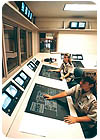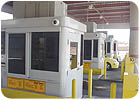VIDEO SURVEILLANCE: Digital Video as a Starting Point

Cynthia Freschi
There’s little question what the industry buzz is these days – it’s this thing called the “enterprise.” Not that the enterprise is new to the business world’s vernacular; it has been used for years in different context incorporating different technologies. The creation of LAN/WAN technology in the computer world initiated the viability of enterprise-wide systems control; but the technology to bridge disparate systems did not exist.
An enterprise system is a generic term to describe a system that is free of geographic boundaries and implemented across an entire business enterprise. Although the IT world has been evoking the power of the enterprise for many years, it is a relatively new concept for security.
What exactly is the enterprise?
It is important that we define the enterprise up front, so that there is no confusion. Speak to an IT professional, and the enterprise is of biblical proportions. Our definition is somewhat more contained – inclusive if you will – to incorporate those security technologies most commonly deployed in large-scale facilities: video surveillance systems, access control systems, fire and alarm systems. It is important to note that we have simplified this definition to four main categories, but each category includes other technologies and systems.For example, the video surveillance category includes video systems used for security and general surveillance applications, which will vary from one facility to the next. Access control also has several layers of systems to be considered, from visitor management to general entry/egress systems and guest key systems. Fire and alarm systems can also contain everything from integration of heat/smoke detectors with HVAC systems, elevator operations, intrusion alarms and RFID car sensors. The ability to monitor, control and integrate the operations of these systems to one another is predominantly a result of software residing on servers with powerful processing capabilities, and in some instances, massive memory. The key is the ability to integrate the operations of these systems so that they truly function together.
This is what we shall define as the enterprise.

Digital video as a platform includes a common interface as well as an ability to identify events and their combinations and relationships. Photo courtesy: NAV
Interfacing versus integration
Just because you can interface all your systems together, you have not integrated your systems’ capabilities. Interfacing involves sending information from one system to another so that they interact with each other. When information is sent from one system and received by another, the combined systems react with a predefined response. For example, an alarm system’s motion detector sounds an alarm and sends a signal to the video surveillance system to reposition cameras and begin recording in real-time, while a series of doors lock and lights are turned on in the affected areas.In most facilities, the security systems are unaware of the status of the other systems to which they are connected. There are many ways to interface systems. In its simplest form, a simple contact closure can achieve a low-level interface. Today, at the enterprise level, there are high level serial or TCP/IP connections capable of handling multiplexed signals across a broad spectrum of systems. These systems share common operational parameters, allowing them to function in unison based on different preprogrammed scenarios. This is the difference between interfacing and integrating.
Integration typically involves the sharing of information between two or more systems with the objective of providing a common user interface. This level of connectivity allows the integrated system to make intelligent decisions based on the status of either or both systems, and results in reduced operator input and increased efficiency.
Enterprise solutions
Enterprise security systems are network-based, employing IP-based technology to relay information between various locations and subsystems. The most significant benefits include the capability to manage all of the systems from a centralized location, or any location on the network. In addition, enterprise security systems allow for systems architecture to be distributed along several network nodes with the ability to share data between multiple systems.Security systems operating on the enterprise level can be configured, operated and changed in countless ways given the nature of the system. Once the network connection is established and a common interface is determined, the configuration can be altered to meet the user’s immediate needs, with the ability to revert to the existing configuration or an entirely new one. Unlike traditional hardware-driven systems, the enterprise security system is limited only by the power of the software controlling it.
With digital video recording (DVR) taking a firm hold, this platform has become the obvious starting point for an enterprise-level security system. In security and surveillance operations, there are a number of systems that can provide information valuable in identifying breaches of procedure and trends in abnormal activity. These systems include, but are not limited to, point of sale, elevators, HVAC, lighting and access control systems. By storing the shared data from these systems and providing a common interface capable of mining the database, specific combinations of events can be readily identified. Generally, this capability is referred to as “data integration” by DVR manufacturers. When this database of activities is integrated with a digital recording system, the video associated with those transactions may be instantly recalled, typically with a simple mouse click.
By integrating a video management system (intelligent matrix switcher) with a digital recording system, recall of recorded events is dramatically simplified. Whereas an operator would normally have to go to a computer workstation to review a recording, the operator can now select the review mode from the matrix switcher’s keyboard, and the recorded video is displayed on any analog video monitor of choice. Depending on the manufacturer, and the number of control functions available from the matrix switcher keyboard, almost all DVR functions may be supported in this manner.

Digital video can provide multiple functions such as these cameras at an airport garage exit. Photo courtesy: NAV
Enterprise Future
There are several viable enterprise-level control interfaces available that combine multiple systems for truly integrated operations. Several security systems feature enterprise-level solutions that tie in previously unrelated systems on an IP platform. The evolution of these new enterprise-level security systems is dramatically changing the way systems are designed and installed. Processing power and bandwidth are key considerations in determining the scope of these new systems as we enter the era of server-based systems.
The Enterprise, Networking and Video
Digital security video – digital video recorders, network recorders, intelligent software image management and IP-based cameras and displays – dominate this month’s International Security Conference in Las Vegas. Security Magazine’s Editor Bill Zalud will launch a daily blog at ISC. Go to www.securitymagazine.com. The blog will include unique input from Security columnist such as Cynthia Freschi and Steve Hunt as well as full-look product reviews such as the network disk recorder from Panasonic (pictured). Features in such new technology include auto IP detection and set-up; data stream control between live and recorded images; and expansion modules allowing up to 7.0 Terabytes storage.In Freschi’s view, elements of an enterprise security system comprise:
- Digital video platforms as a solid enterprise-level starting point.
- A common interface for mining collected data.
- Ways to associate video with other systems’ information.
- Ways to bring intelligence into design for decision-making and event management.
Looking for a reprint of this article?
From high-res PDFs to custom plaques, order your copy today!





